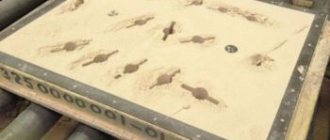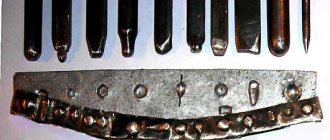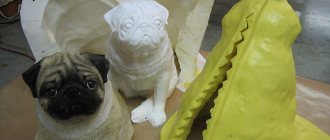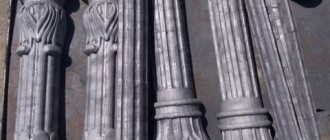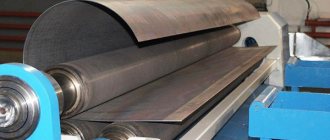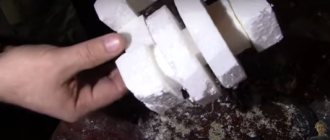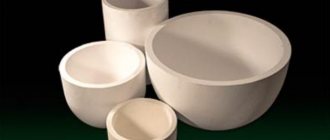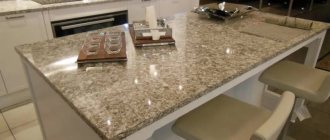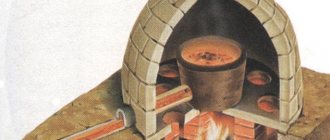The following requirements apply to molding mixtures for casting:
- mechanical strength;
- thermal conductivity;
- gas permeability;
- fire resistance;
- heat capacity.
Molding and core mixtures have similar qualities. But the highest demands are placed on the rods, because the molten alloy exerts the most powerful pressure on them.
Composition of different consistencies
Molding sands are divided into three types:
- united;
- facing;
- filler.
A single mixture is intended to fill the entire size of the mold. It is used in full during machine molding when producing castings in large quantities. For its manufacture, large quantities of previously unused materials are used.
The facing mixture is intended to produce a mold layer that is in direct contact with the melt. Its thickness depends on the type of mixture and the severity of the casting and ranges from 20-100 mm. In order to fill the remaining size, a filling mixture is used.
The composition of the molding sand directly depends on the shape and method of its production. The formation of sand-clay forms occurs using 2 methods, which result in dry and wet forms. To make them pliable during formation, combustible fillers - peat or sawdust - are introduced into the mixture. In addition to clay and sand, the composition of the dried forms includes fastener, crushed asbestos and stillage.
In addition to them, the following are used:
- rapidly curing;
- self-curing;
- hardening during chemical transformation;
- liquid glass compositions.
In rapidly curing consistencies, liquid glass acts as a binder. If warm blowing is needed to dry watery glass, then hardening occurs due to ferrochrome slag.
Systematization of molding consistency
Without the help of others, curing compounds in the initial state are watery. Then surfactants and sand filler are introduced into them. This composition remains fluid for no more than 10 minutes. Therefore, they are prepared in the molding areas.
Chemically curing mixtures have a short lifespan. As a result, caustic soda is added to the mixture.
After formation, liquid glass varieties are dried by blowing with carbon dioxide. During the drying process, chemical reactions occur: the formation of silicic acid and sodium carbonate.
To produce a rod, for example, first class, the mixture consists entirely of quartz and fasteners. To form large rods, 1/3 of the used and reconstituted composition is used.
The melting point of non-ferrous metals is significantly lower than that of steels and cast irons. This is why molding mixtures have the least fire resistance. For casting bronze and copper alloys, molding compositions are prepared using class P clay sand. Fillers such as boric acid, sulfur or fluoride additives are used for aluminum casting. They prevent active oxidation of the melt.
Types of alloys
Bronze includes copper and alloying additives (beryllium, lead, aluminum, silicon and tin) in its base. All its alloys also contain components such as zinc, phosphorus, etc. In addition to bronze, modern industrial production also produces other alloys from copper - constantan, copel, nickel silver, cupronickel, brass, etc.
The amount and type of alloying components in the composition of a bronze alloy describes its chemical and physical properties, as well as the color of the material.
Brands of bronze alloys, the melting point of which lies in the range from 930 to 1140 degrees Celsius, have their own markings. Based on their chemical composition, bronze-based alloys are classified into:
People have learned to combine tin with copper to produce bronze since ancient times. Tin makes the material stronger and also reduces its melting temperature characteristics. A striking example of this type of alloy is bell bronze. It contains 20 percent tin and eighty percent copper. But products made on the basis of bell bronze are characterized by the highest fragility.
Read also: Differences between batteries with reverse polarity
Tin-free bronzes, as the name suggests, do not contain tin. Such alloys are now classified into separate groups of bronzes:
- Beryllium - more durable, superior to steel in almost all features;
- Silicon-zinc - have high resistance to abrasion (the advantage of bronzes of this group is that when molten they have higher fluidity);
- Based on aluminum and copper - they differ in the highest anti-corrosion protection and beautiful anti-friction properties.
Nowadays, bronzes with tin added are most widely used. For the purpose of marking the material, regardless of the composition, the designation “Br” is used, after which the additives used and their content in the material are indicated. For example, you can decipher the bronze “BR OTSSNZ-7−4−2-. This tin alloy contains tin, zinc, lead and nickel. The numbers indicate their percentage in bronze. The composition of any brand of bronze may contain other elements with the following designations:
- A - duralumin alloys;
- B - beryllium-based alloys;
- F - ordinary iron;
- K - silicon element;
- Mts - ordinary manganese;
- F - phosphorus.
Interesting read: Dyes for anodizing aluminum
Required characteristics
To obtain a high-quality casting, you need a casting mold made from ingredients selected for casting a specific alloy. The molding sand for casting must have a certain moisture content. At low humidity, the mold is prone to crumbling, which makes molding difficult.
Poor gas permeability provokes the formation of defects in the casting - gas pores and cavities. Why is sand of a large fraction (more than 50%) needed?
The characteristics of molding consistency are characterized by hardness. It depends on the uniformity and degree of compaction. Compaction of the form beyond the norm provokes the appearance of such defects as:
- burn;
- spread;
- boil
Casting in sand-clay mold
The highest strength of the mold and core does not allow changing the geometry of the casting. To obtain it, special binding materials are used.
Non-stick coatings
To improve the surface cleanliness of castings, non-stick coatings - paints - are applied to the working surfaces of the molds and cores. The coating is a mixture of dust-like refractory material with water and binders. The applied layers of paint reduce the roughness of the forms and close the pores between the grains of sand. As a result, the surface of the casting is smoother and cleaner, without burning.
Iron casting molds are coated with carbon-containing coatings consisting of graphite, bentonite, water and other substances.
Non-stick mixtures for steel castings include dusted quartz, zircon, magnesite, and for castings made of non-ferrous metals, fine talc. Coatings are applied to both hot and cold molds. Coatings are also used for surface modification and alloying.
Molding clays
Clay is the more common binding material in molding mixtures. Molding clays, like sands, belong to sedimentary rocks. They consist of small particles of aqua aluminosilicates with sizes <0.022 mm. A distinctive feature of clay is its ability to swell in water, and the more clay is able to retain water, the higher its binding and plastic characteristics.
Depending on the mineralogical composition, clays are divided into three types: bentonite, kaolin, also kaolin-hydromica and polymineral (GOST 3226-77). Kaolin and bentonite clays are more widely used in foundry production. Bentonite clays have very high binding properties because they are able to retain more water than other types of clays. When using them, this makes it possible to reduce the clay content in molding mixtures by 2-3 times and thereby increase the fire resistance and gas permeability of the mixtures. Bentonite clays are used in the production of high-quality molding mixtures and mixtures for automatic lines, where mixtures with the highest and measured qualities are especially needed. Due to the loss of crystallization water at high drying temperatures (120–200 °C), bentonite clays irreversibly lose their binding ability, which is why they are used only for wet molding. A disadvantage of bentonite clays is their reduced fire resistance (1250–1300 °C).
The main mineral of kaolin clays is kaolinite Al2O3 2SiO2 2H2O, which has a melting point of 1750-1787°C. Kaolin clays are characterized by the least ability to swell in water.
In addition to the main mineral, clays include quartz, feldspar, mica, and also harmful impurities: Fe2O3, Na2O + K2O, CaO + MgO. Harmful impurities reduce the fire resistance of clays and their thermochemical stability.
According to the content of harmful impurities, clays are divided into three groups: with the highest T1, medium T2 and low T3 thermochemical stability.
The binding capacity of clay is assessed by the compressive strength of the mixture in wet and dry conditions. Based on the tensile strength in the wet state, molding clays are divided into three groups: P - strong binding, S - medium binding and M - low binding (Table 3.3).
In the designation of a clay grade, the 1st letter means the type of clay according to the mineral composition, the 2nd - the group according to the strength limit in a wet state, the 1st digit - a subgroup according to the strength limit in a dry state, and the letter T with an index - the group of clay according to content harmful impurities. For example, kaolin molding clay with a strong binder in the wet state, medium binder in the dry state, with the highest thermochemical stability is designated KP2T1. The BS1T3 brand designates bentonite molding clay, medium-binding in the wet state, strong-binding in the dry state, with low thermochemical stability.
Casting using gasified models - casting with loss of foam
Lost wax casting refers to those casting methods that are high-tech and more economical. The essence of the technology is lost wax casting, but in a permanent form. Translated from English - casting with loss of foam.
Gas casting models
The casting model when casting using gasified models is made of expanded polystyrene (foam plastic). Small models are made in aluminum molds using the foaming method at a temperature of about 130C followed by cooling. Polystyrene molds are cast using precision casting. Their use makes it possible to produce several thousand foam models in a short time.
Large models, castings of which can reach several tons and single copies are cut from slabs according to a template manually using nichrome wire under tension or on engraving and milling machines with PU.
The finished model is coated with paint and a fire-resistant compound on top.
Forming operation
The finished model of simple-shaped castings with a gas-permeable and fire-resistant shell is sent for molding. It is installed in the flask and filled with molding sand. Compaction occurs on a vibrating table. The flask is closed with lids and the gating system bowl is installed.
For models with complex casting geometry, the molding operation is performed by vacuuming. Cover the flask with plastic film. To prevent the destruction of the model, a reduced pressure (vacuum) of minus 4-5 Pa is created in the mold.
The molding operation of large-sized models is carried out using bulk or liquid mixtures.
Fill
Molten metal is poured into a mold. At this time, expanded polystyrene begins to gasify. Its gasification temperature is 560C. Gradually the molten metal fills the mold. The resulting gases are removed by a vacuum system. In its absence, the working area in the workshop becomes smoky, exceeding the permissible values by tens of times.
After the part has cooled and hardened, the flask is turned over and the molding mixture is separated from the casting. If an ordinary molding mixture was used, then the separation occurs on knockout grids.
Advantages of the gasified casting method
The main advantage of this casting method is considered to be the high quality of the resulting castings, comparable to those cast in a mold or lined mold. This is achieved by the absence of a prefabricated uniform.
Modern production uses water-based non-stick coatings for:
• casting of large and medium-sized samples or parts in small-scale production;
• castings of parts whose weight reaches 50 kg, having a complex configuration, with the presentation of increased dimensions in terms of accuracy, in serial and large-scale production.
This method is used to cast parts from: all grades of steel, cast iron, copper and its alloys (brass, bronze), aluminum and its alloys (casting grades). Almost 90% of the resulting products do not require subsequent mechanical processing.
Overall rating of the article:
Published:
2017.11.14
_ _ _ _ _ _ _ _ _ _ _ _ _ _ _ _ _ _ _ _ _ _ _ _ _ _ _ _ _ _ _ _ _ _ _ _ _ _ _ _ _ _ _ _ _ _ _ _ _ _ _ _ _ _ _ _ _ _ _ _ _ _ _ _ _ _ _ _ _ _ _ _ _ _ _ _ _ _ _ _ _ _ _ _ _ _ _ _ _ _ _ _ _ _ _ _ _ _ _ _ _ _ _ _ _ _ _ _ _ _ _ _ _ _ _ _ _ _ _ _ _ _ _ _ _ _ _ _ _ _ _ _ _ _ _ _ _ _ _ _ _ _ _ _ _ _ _ _ _ _ _ _ _ _ _ _ _ _ _ _ _ _ _ _ _ _ _ _ _ _ _ _ _ _ _ _ _ _ _ _ _ _ _ _ _ _ _ _ _ _ _ _ _ _ _ _ _ _ _ _ _ _ _ _ _ _ _ _ _ _ _ _ _ _ _ _ _ _ _ _ _ _ _ _ _ _ _ _ _ _ _ _ _ _ _ _ _ _ _ _ _ _ _ _ _ _ _ _ _ _ _ _ _ _ _ _ _ _ _ _ _ _ _ _ _ _ _ _ _ _ _ _ _ _ _ _ _ _ _
Making consistencies
The process of making molding and core mixtures is carried out in three steps. The 1st step is preliminary. Here the preparation of still unused materials takes place. Drying, crushing and subsequent sifting are carried out.
The second step involves preparing the spent composition. This allows you to save on materials. The process begins on the cooling drums. Knocking, crushing, cooling occurs.
Molding sands for casting are prepared in the 3rd step in mixers. Roller models have found widespread use. They are used for the manufacture of such compositions as:
- united;
- core mixtures;
- facing;
- with additives: viscous;
- watery;
- dusty.
With huge release sizes, creation is automated. Mechanization of actions is reflected in the reduction of production costs.
Do-it-yourself molding mixture for casting aluminum
There are several aluminum casting techniques that are used in production on an industrial scale. But if we are talking about work at home, then a more acceptable method is pouring watery aluminum into homemade molds. This is the technology we will talk about.
Interesting read: How to cook aluminum with an inverter without argon
Before we deal with the aspects of casting, it is important to remember some of the properties of this alloy. Aluminum melts at a temperature of about 660 ° C (depending on its purity), and boils at 2,500. Another highlight that must be taken into account is rapid oxidation upon direct contact with air.
There are quite a lot of different “engineering solutions” that can be implemented when casting aluminum yourself at home. “Folk craftsmen”, knowing its properties, select the necessary devices and materials themselves.
One of the main problems is what and how to make a mold for filling. This is where people who have no practical experience most often stumble.
Therefore, we will consider only one of the simple options, because it is unrealistic to cover all the methods in one article.
Let's start with what will need to be prepared for casting:
Aluminum scrap
Any of us has encountered this alloy. But has everyone noticed that, for example, aluminum wire can be different? One simply bends, like plasticine, and the other is the toughest, least flexible. For casting, it is better to choose the one that is softer, because such a material, relatively speaking, contains less oxides and more “pure” aluminum.
The most common option for working from home. Its best brand is sculptural (marked “G – 16”). But it has yet to be found, and the cost of such a high-quality product is quite high. Therefore, in everyday life, snow-white gypsum (designated “G - 7”) is often used, which is not a disadvantage. It can be purchased at any specialty store that sells building materials.
It is very similar in appearance to alabaster, and it is easy to confuse them. In addition, the merchant, not knowing why the buyer needs gypsum, can offer this “analogue” instead. In the construction industry, materials often replace each other because almost all of their properties are identical. But alabaster is literally not suitable for the production of molds! This must be taken into account.
What is mold casting?
- Casting in clay molds
Ceramic molds are assembled from two parts. They are made from a watery molding consistency with the addition of a gelling binding agent.
- Shell casting
It is made by obtaining a casting using a special mold. The prefabricated system consists of 2 sand-resin shells made of small grain quartz sand and artificial resin.
When heated to 140 degrees Celsius, the resin melts, when heated to 250 degrees Celsius, it hardens, and at 600 degrees, it evaporates, forming pores for gases to escape.
Shell die casting is characterized by the highest productivity, accuracy and high-quality surface of the resulting workpieces. Used in large-scale production of castings weighing up to 100 kg.
- Sand casting
Castings are created by placing a suitable shape in sand or a mixture of sand and clay in special molds. This casting method was used in ancient times.
At the moment, a similar method is not used so often, it is being replaced by the most modern types of casting and is used mainly in handicraft production in small craft workshops.
A model of a suitable configuration and size (a little larger so that there is room for shrinkage) is placed in a flask in a sand mixture, which is compacted and the flask is heated. After this, the model is taken out and a suitable composition, for example an alloy, is poured in instead.
After the alloy has cooled, the casting is taken out, processed, and cleaned of any remaining sand and clay.
- Casting in silicone molds (templates)
Development of casting in molds of template blanks. The essence of the method is that the working cavity into which the molten alloy is poured is not formed using prepared models.
Using a specially made template, the working part of which extrudes excess molding sand from the matrix. Casting into template molds occurs on the principle of drawing or rotating the molds.
Mold casting is used in working with various types of metals: casting iron, casting bronze, casting aluminum.
CASTING MODELS
Based on drawings and casting technologies developed by a technologist or designer, an experienced modeler makes a model of a part from wood, metal or plastic or polystyrene foam.
The metal shrinks during the cooling process, and crystallization may be heterogeneous due to uneven cooling. Thus, the model should be slightly larger than the finished casting, using the so-called metal shrinkage factor. Different shrinkage rates are used for different metals. During the molding process, models leave imprint cavities in the sand, into which a sand core is placed. Such rods are sometimes reinforced with wire reinforcements, which are used to create cavities that cannot be formed by the main model, such as internal valve passages or cooling spots in engine blocks.
The gating system for the entry of metal into the mold cavities is a guide and includes a funnel and sprues that maintain a good pressure of liquid metal for more uniform filling of the mold cavity. The gas and steam generated during casting escape through permeable sands or through risers, which are made either in the model itself or in the form of separate parts.
Flasks for molding materials Two or more flasks are used for molding. The flasks are made in the form of boxes that can be connected to each other and fastened together. The model is recessed into the lower part of the flask up to its widest cross section. Then the upper part of the model is mounted. The upper part is attached to the lower part of the flask with clamps and the molding mixture is added there and compacted so that it completely covers the model. Sprues and thrusts are installed in the required places. Then the flask is halved and the model, wooden sprues and stops are removed from it.
METAL COOLING
To control the crystallization of the metal structure, metal plates and refrigerators can be placed in the mold. Accordingly, rapid local cooling forms a more detailed metal structure in these places. In black casting, the effect is similar to hardening the metal in a forge. In other metals, condensers can be used to control the directional solidification of the casting. By controlling the cooling method of the casting, internal voids or porosity within the casting can be prevented.
PRODUCTION
Rods are used to create cavities in castings, such as for coolant in engine blocks and cylinder heads. Typically, casting cores are placed in the mold after the model is removed. After drying, the flask with the mold is placed on the foundry platform to be filled with molten metal, usually steel, bronze, brass, aluminum, magnesium and zinc. After filling with liquid metal, the flasks are not touched until the casting has cooled. After knocking out the casting, the cores are removed from the casting. The metal of the sprues and profits must be separated from the casting by any means. Various heat treatments can be used to relieve stress from initial cooling and add hardness in the case of water or oil quenching. The casting surface can be further hardened by shot peening, which adds resistance to cracking and stretches and smoothes out rough surfaces.
TECHNOLOGY DEVELOPMENT
To make it possible to remove the model without violating the integrity of the molding sand, all parts of the model must be pre-calculated by the technologist and have significant parts for installing the rods. A slight slope should be used on surfaces perpendicular to the parting line to allow the model to be removed from the mold. This requirement also applies to rods, since they must be removed from the cavities they form. The vents and risers must be located so as to ensure optimal flow of metal into the mold and gases from it in order to avoid underfilling of the casting.
Methods of casting into the ground
There are two methods of casting in sand molds, the first is using “raw” sand, the so-called raw molds, and the second is the liquid glass method. Wet Molds Wet sand is used to make a mold in a flask. The name comes from the fact that wet sand is used in the molding process. “Raw sand” is a mixture of: -siliceous sand (SiO2), or chromium sand (FeCr2O), or zirconium sand (ZrSiO4), from 75 to 85%, and other components, including graphite, clay from 5 to 11%, water from 2 to 4%, other inorganic elements from 3 to 5%, anthracite up to 1%. There are many molding mixtures with clay, but they all differ in the plastic properties of the mixture, the quality of the surface, as well as the possibility of using molten metal in casting in relation to the throughput for the release of gases. Graphite, as a rule, is contained in a ratio of no more than 5%; it partially burns upon contact with molten metal with the formation and release of organic gases. Raw mixtures are generally not used for casting non-ferrous metals, since raw molds lead to strong oxidation, especially for copper and bronze casting. Raw sand molds are not used for aluminum casting. For aluminum casting, higher quality molding mixtures are used. The choice of sand for molding depends on the temperature of pouring the metal. The pouring temperature of copper, steel and cast iron is higher than other metals, therefore, clay is not further regenerated from exposure to high temperatures. For pouring cast iron and iron-based steel, they usually work with quartz sand - it is relatively inexpensive compared to other sands. Since the clay burns out, a new portion of clay and some of the old sand are added to a new portion of the sand mixture. Silicon is undesirable in sand because The grains of quartz sand tend to explode when exposed to high temperatures during pouring. These particles are suspended in the air, which can lead to silicosis in workers. The foundry has active ventilation to collect dust. Fine sawdust (wood flour) is added to create space, when burned, for the sand grains to expand without deforming the shape.
Purpose
Sedimentary rock is widely used:
- when casting into the ground;
- in the production of molding and core mixtures (unstained quartz sand);
- for sandblasting;
- in the sandboxes of railway locomotives (fraction 0.2–0.5 mm).
Coarse sand is suitable for the production of huge and thick-walled castings with good fire-resistant and gas-permeable qualities. Finely dispersed is needed for thin castings in color and artistic casting in order to obtain the most high-quality surface.
Quartz sand with the least amount of harmful impurities is used for iron casting.
Skinny or fat – with high clay content – for the production of metal and non-ferrous alloys.
Using the method of casting in the ground, using molding sand, you can make a huge number of parts of regular and complex geometric shapes. Among them are ordinary rings, wheels, reinforcement elements, blanks for gear wheels, complex body parts and frames.
Definitions
There are several types of sand; to understand the essence of the issue qualitatively, it is necessary to familiarize yourself with the main differences:
natural sand. A material that has a free-flowing state, while it is inorganic. The grains reach a size of 5 mm. Sand is obtained due to the natural crushing of rocks. It is obtained by extracting it from sand deposits or mixed with gravel;
Natural
- special equipment for enrichment can be used;
- crushed. The grain size does not differ and is less than 5 mm. Manufactured by humans using special crushing and grinding equipment. Obtained by crushing rocks;
Crushed
fractional. This is homogeneous sand that has been previously divided into 2 or more fractions. For this purpose, special sifting equipment is used;
Fractional
screenings from crushing. Product of inorganic origin, grain size up to 5 mm. It is obtained by sifting out destroyed mountain rocks. It is a secondary product in the production of crushed stone and some types of metals. Also obtained from certain non-metallic minerals.
Stamps
Depending on the quartz content and the size of the grains, quartz molding sand is assigned a brand in the form of a digital notation “2-K2-O1-02”. From it you can find out:
- clay content;
- homogeneity coefficient;
- average grain size.
Decoding quartz sand brands
- Mass fraction of clay - 1st digit - from 1 to 5, where 1 indicates a small 0.2%, and 5 - the largest 2%.
- The mass fraction of quartz is from K1 to K5, where K1 is 99% quartz, and K5 is 93%.
- Uniformity – from O1 (80% homogeneity) to O5 (45–50%).
- Fractionality (the last two numbers in the marking) – 01 – up to 0.18 mm, 02 – from 0.2 to 0.23 mm, 025 – from 0.24 to 0.27 mm, 03 – up to 0.3 mm.
For example, dry molding sand grade 2K2O102 : 0.45% mass fraction of clay, 98% quartz, the highest degree of homogeneity of 80% and an average size of fractions of 0.2–0.23 mm.
There are other brands of molding sand. For example, in skinny, the clay component reaches 12%, and in the least strong fatty, the clay content ranges from 12–50%.
TRANSPORTATION AND STORAGE
5.1. Molding sands are transported in accordance with the rules for the transportation of goods in force for this type of transport, the technical conditions for loading and securing goods, approved by the Ministry of Railways and GOST 22235.
The bags are packaged in accordance with GOST 26663, GOST 24597, GOST 21650 and GOST 22477.
5.3. It is allowed, by agreement between the manufacturer and the consumer, to transport molding sands with a mass fraction of moisture less than 0.5% in cement hoppers and cement tanks.
5.4. Frozen molding sands are unloaded using thermal and mechanical means of restoring flowability.
5.5. Molding sands with a mass fraction of moisture over 0.5% are stored separately by grade, with a mass fraction of moisture up to 0.5% - separately by grade in covered warehouses or bunkers.
INFORMATION DATA
1. DEVELOPED AND INTRODUCED TC 252 “Foundry”
2. APPROVED AND ENTERED INTO EFFECT by Resolution of the Committee for Standardization and Metrology of the USSR dated December 28, 1991 No. 2263
3. INSTEAD GOST 2138-84
4. REFERENCE REGULATIVE AND TECHNICAL DOCUMENTS
| Designation of the referenced technical document | Item number |
5. REPUBLICATION. July 2005
Characteristics
Depending on the content of clay and harmful impurities, molding material is divided into classes. Coarse sand has consistently fewer contaminant minerals and impurities. The property is reduced if the composition contains:
- calcium oxide (CaO);
- magnesium oxide (MgO);
- alkali oxides (Na2O, K2O);
- ferrous oxide (FeO), etc.
Depending on the mass fraction of impurities, molding sand belongs to one of 5 groups. The most pure is the 1st, in it the mass fraction of alkali oxides does not exceed 0.45%, and iron oxide – 0.22%. In the fifth, dirtiest group, the amount of alkali oxides increases to 2.3%, and iron oxides - to 1.1%.
The composition of quartz sand does not have to contain peat and earth, coal and limestone, pieces of slate, quartzite, sandstones and other polluting components. The very permissible mass fraction of sulfide sulfur is not more than 0.05%.
If there are a lot of harmful impurities - alkali oxides and iron oxide, the surface properties of the castings will be low, and burnt marks will appear on them. The purer the sand, the better its fire-resistant properties.
Physical Characteristics of Molding Sand
The properties of castings and consistencies are influenced by the physical characteristics of the material:
- strength - the ability to maintain initial characteristics during casting or transportation;
- gas permeability – the surface property is better with low gas permeability;
- thermal stability - the ability to maintain a given shape when exposed to high temperatures;
- subsidence ability - the property of the mixture to compress during the solidification of the cast part;
- reuse.
Pulverized quartz with an iron content of up to 0.25%, as well as dry molding sand grade 2K20102, have good performance characteristics - strength and thermal stability, low gas permeability.
You can order molding sand of various brands by multi-line telephone.
Scope of application
Possessing unique characteristics, quartz sand has found wide application in human life and is used in the following areas:
- used in construction for the manufacture of various types of decorative plasters, dry mixes, as well as for the creation of self-leveling floors;
- for casting heat-resistant molds in the metallurgical field;
- for swimming pools as a filter material;
- for football fields as a covering;
- in the production of glass, fiberglass;
- in the production of building materials - for the production of sand-lime bricks, paving stones, refractory concrete;
- in the agro-industrial sector as an additive to animal feed;
- in the production of electrical fuses, since quartz is a dielectric material;
- for creativity and drawing, in landscape design;
- when preparing mixtures for the production of high-strength reinforced concrete.
Quartz sand is included in modern road pavements, since silicon dioxide is durable and abrasion-resistant, which allows the asphalt surface to be durable and reliable, despite the huge weight load and high traffic. Most types of dishes that are on the shelves are made using quartz sand. The mineral additive of fine-grained quartz allows it to be added to porcelain, earthenware and ordinary glass, which gives these materials increased strength and shine. Quartz is also added in the manufacture of technical glass, as well as window and automobile types; it is used to produce laboratory glassware that is resistant to heat and chemical environments, and is also added to the composition of the mass intended for the production of ceramic finishing tiles.
But that's not all. Quartz sand is an integral component used in the production of optical lenses, making these products smooth, transparent and durable to use. Due to its ability to retain heat, quartz sand is used for industrial and domestic needs. With his participation, electric heating devices are manufactured - quartz is included with an incandescent spiral system, which quickly heats up and maintains the required temperature for a long time.
Engraving work and grinding of surfaces, as well as processing of stone, metal or durable polymers cannot be done without the use of quartz sand, which is used in the sandblasting technique for processing materials. The essence of the process is that sharp-angled rock particles, mixed with an air flow, are supplied under a certain pressure to the surface being processed, which is polished and becomes perfectly clean and smooth.
The well-known ability of quartz sand to absorb various substances is used to filter water in hydraulic structures of various types and purposes. In addition, the adsorbing properties are used in the food industry, as well as in the production of filter equipment.
To learn how to choose the right quartz sand for a pool, watch the following video.
